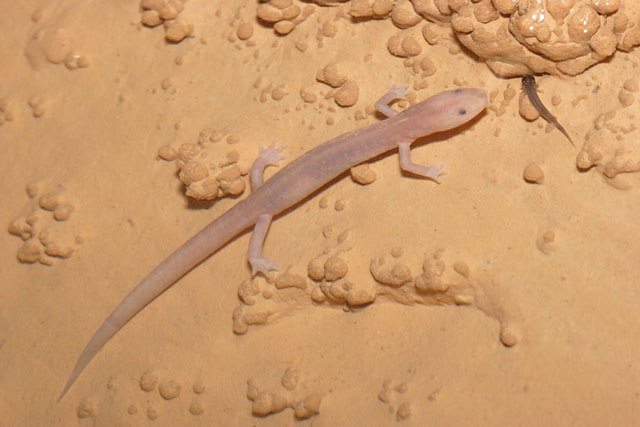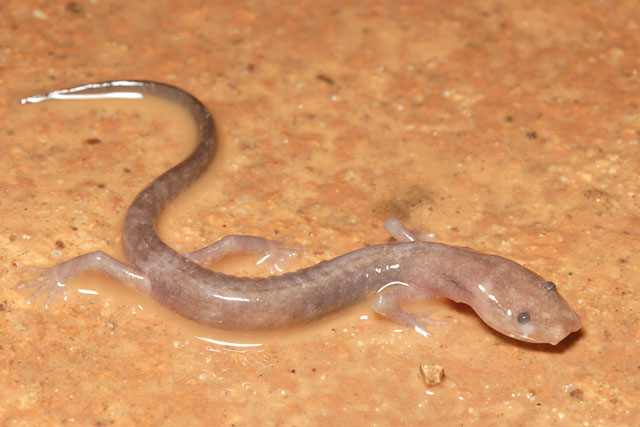|
A friend of mine (Mick) is
a professional cave biologist and during the
winter months I sometimes accompany him with his research. Right now he
is working on a project
to assess the impact on cave fauna in caves that are open to the public. Round
Spring Cave in Shannon County Missouri is one of the six caves being monitored and is the cave we visited just the other day.
Round Spring Cave is gated and locked but it is open to the public by means of guided tours held daily
throughout the summer months by the National Park Service. Normally grotto salamanders are hard to come by but it seems our
visit landed during a peak time for grotto salamander viewing. I was told that if we had visited a month or two earlier we
would have found mostly cave salamanders (E. lusifuga) as this is the time they are laying eggs in the caves. The unusual
feature of this circumstance is that the egg laying is taking place in quiet pools with deep mud, rather than under rocks
in flowing streams, as had been assumed to always be the case. The main evidence is that adults have been observed diving
into the mud and are almost always mud-covered, then shortly after the occurrence of adults in the pools peaks, newly hatched
larvae start to appear in the same pools, and gradually build in numbers. Mick has not demonstrated for certain that these
are E. lucifuga larvae, but it looks like a good bet. Anyhow, when these larva appear the grotto salamanders soon show up,
presumably to feed on the cave salamander larva. In the first photo you can see an adult grotto salamander in a pool along
with what's thought to be a cave salamander larva. The second photo is of a darker (newly metamorphed?) adult found among
larva in another pool.
I was also shown some remains (bones) of the extinct short-faced bear in a passage of the cave
that is off limits to tours.
Most exciting was the
discovery of an undescribed beetle; only the second troglobitic beetle ever found in the Ozarks. Sue (Mick’s
wife) had found the first only months earlier in another Shannon County cave, and Mick had been telling me about it on the drive to the cave. Under the microscope it was obvious that the
beetle had evolved a complete lack of eyes.
Bat Species Seen:
Big Brown Bat
Eastern
Pipistrelle
Indiana Bat
Gray Bat


Following is a copy of Mick's
notes concerning amphibians from the trip, including totals.
Amphibians
Entrance
passage: none. Stream bed dry
Right Fork: stream bed
dry at T-junction, grading to static pools, some
deep.
Inlet stream dry. Pool at inlet
jct with recently dead
pickerel
frog (c. 4.5 cm). Small (12-15 mm) salamander larvae: 1
Fountain
of Youth pools: small (12-15 mm) salamander larvae: 45 (main
pool 16); Typhlotriton spelaeus adults: 3 (all in
pools with small larvae), large Typhlotriton larva: 1
Beyond
FOY: in static stream bed pools, small larvae: >36; Typhlotriton
adult (in pool with small larvae): 1; Dragon's
Mouth pools - lots of
salamander tracks.
North
branch: static muddy pools, large Typhlotriton larva: 1, small
larvae: 73; Eurycea lucifuga adult in pool, partly
mud covered (mud to 3 cm deep).
Left Fork to start
of Tobacco Barn: Theater Hill pools: small salamander larvae: 44. Main stream: E. lucifuga adults in stream: 2; Typhlotriton
adult: 1; unidentified dead frog (slime covered).
Totals:
Rana palustris: 1 (dead)
Unidentified
frog: 1 (dead)
Typhlotriton
spelaeus: 5 adults, 2 large larvae
Eurycea
lucifuga: 3 adults
Unidentified
Eurycea type larvae: 200
|

